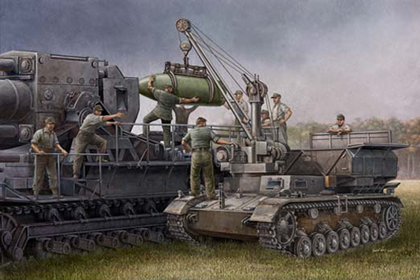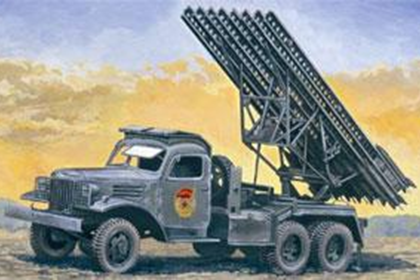This is the Trumpeter 00363 kit in 1/35 scale, of the ‘German Pz.Kpfw.IV Ausf. F Fahrgestell’.

History
There were two Munitionsschlepper for each of the six Gerät 040 Nr. I to VI and one for the experimental Gerät Nr. VII.
This is the Trumpeter 00363 kit in 1/35 scale, of the ‘German Pz.Kpfw.IV Ausf. F Fahrgestell’.

There were two Munitionsschlepper for each of the six Gerät 040 Nr. I to VI and one for the experimental Gerät Nr. VII.
This is the Trumpeter 00219 kit in 1/35 scale, of the ‘German Panzerlok BR57 Armoured Locomotive’.

The Deutsche Reichsbahn-Gesellschaft (DRG), or German National Railway between 1920 and 1945, saw armored trains as a way to preserve and advance a military presence. By keeping a strong military face on this state owned railroad.
The BR57 armored trains locomotive was actually based on the Prussian series G10 locomotive first built in 1910 and featuring an 0-10-0 wheel arrangement.
![]()
This is the Eduard, photo etch set for the ‘Russian BM-13, Katyusha‘ from Italeri.
Detail set |
Italeri |
||||
| (35 803) | Basic | 6242 | ✓ | ||
Source: Eduard
This is the Trumpeter 01510 kit in 1/35 scale, of the ‘German Kommandowagen’.

The two halves of the train, before and behind the locomotive were identical and consisted of one artillery car with one 10cm le.F.H 14/19(p) gun, one command and infantry car and one artillery and anti-aircraft car with one 7.62cm F.K.295/l(r) and one 2cm anti-aircraft quadruple unit.
![]()
This is the Eduard, photo etch sets for the ‘Russian Heavy Tank, JS-3M‘ from Trumpeter.
Detail set |
Trumepter |
||||
| (35 571) | Basic | ||||
Source: Eduard
This is the Trumpeter 00316 kit in 1/35 scale, of the ‘Russian Heavy Tank, JS-3M’.

New wheels were added from the T-10 heavy tank which, had improved ball-bearings. In addition, external stowage was improved and dust shirts were added over the suspension.
This is the Italieri 6264 kit in 1/35 scale, of the ‘Russian BM-13, Katyusha’.

They are fragile compared to artillery guns, but are inexpensive and easy to produce.Katyushas of World War II, the first self-propelled artillery mass-produced by the Soviet Union, were usually mounted on trucks. This mobility gave the Katyusha (and other self-propelled artillery) another advantage: being able to deliver a large blow all at once, and then move before being located and attacked with counter-battery fire.
This is the Dragon 3528 kit in 1/35 scale, of the ‘Israeli M-50, Super Sherman’.
